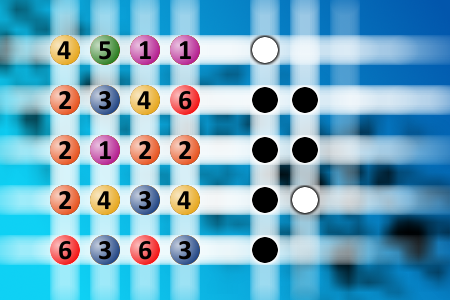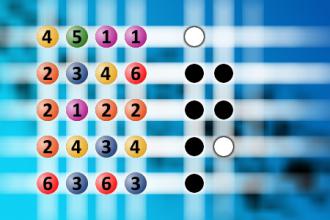Which is a winning combination of digits?
The computer chose a secret code (sequence of 4 digits from 1 to 6). Your goal is to find that code. Black circles indicate the number of hits on the right spot. White circles indicate the number of hits on the wrong spot.Correct answers: 66
The first user who solved this task is On On Lunarbasil.
#brainteasers #mastermind

Snowboarding Lesson
When you're 47 years old, you sometimes hear a small voice inside you that says: "Just because you've reached middle age, that doesn't mean you shouldn't take on new challenges and seek new adventures. You get only one ride on this crazy carousel we call life, and by golly you should make the most of it."
This is the voice of Satan.
I know this because recently, on a mountain in Idaho, I listened to this voice, and as a result my body feels as though it has been used as a trampoline by the Budweiser Clydesdales.
I am currently on an all-painkiller diet. "I'll have a black coffee and 250 Advil tablets" is a typical breakfast order for me these days.
This is because I went snowboarding.
For those of you who, for whatever reason, such as a will to live, do not participate in downhill winter sports, I should explain that snowboarding is an activity that is popular with people who do not feel that regular skiing is lethal enough.
These are of course young people, fearless people, people with 100 percent synthetic bodies who can hurtle down a mountainside at 50 miles per hour and knock down mature trees with their faces and then spring to their feet and go, "Cool."
People like my son. He wanted to try snowboarding, and I thought it would be good to learn with him, because we can no longer ski together.
We have a fundamental difference in technique: He skis via the Downhill Method, in which you ski down the hill; whereas I ski via the Breath-Catching Method, in which you stand sideways on the hill, looking as athletic as possible without actually moving muscles (this could cause you to start sliding down the hill).
If anybody asks if you're OK, you say, "I'm just catching my breath!" in a tone of voice that suggests that at any moment you're going to swoop rapidly down the slope; whereas in fact you're planning to stay right where you are, rigid as a statue, until the spring thaw.
At night, when the Downhillers have all gone home, we Breath-Catchers will still be up there, clinging to the mountainside, chewing on our parkas for sustenance.
So I thought I'd take a stab at snowboarding, which is quite different from skiing.
In skiing, you wear a total of two skis, or approximately one per foot, so you can sort of maintain your balance by moving your feet, plus you have poles that you can stab people with if they make fun of you at close range.
Whereas with snowboarding, all you get is one board, which is shaped like a giant tongue depressor and manufactured by the Institute of Extremely Slippery Things. Both of your feet are strapped firmly to this board, so that if you start to fall, you can't stick a foot out and catch yourself. You crash to the ground like a tree and lie there while skiers swoop past and deliberately spray snow on you.
Skiers hate snowboarders. It's a generational thing. Skiers are (and here I am generalizing) middle-aged Republicans wearing designer space suits; snowboarders are defiant young rebels wearing deliberately drab clothing that is baggy enough to cover the snowboarder plus a major appliance. Skiers like to glide down the slopes in a series of graceful arcs; snowboarders like to attack the mountain, slashing, spinning, tumbling, going backward, blasting through snowdrifts, leaping off cliffs, getting their noses pierced in midair, etc.
Skiers view snowboarders as a menace; snowboarders view skiers as Elmer Fudd.
I took my snowboarding lesson in a small group led by a friend of mine named Brad Pearson, who also once talked me into jumping from a tall tree while attached only to a thin rope.
Brad took us up on a slope that offered ideal snow conditions for the novice who's going to fall a lot: Approximately seven flakes of powder on top of an 18-foot-thick base of reinforced concrete.
You could not dent this snow with a jackhammer. (I later learned, however, that you COULD dent it with the back of your head.)
We learned snowboarding via a two step method:
Step One: Watching Brad do something.
Step Two: Trying to do it ourselves.
I was pretty good at Step One. The problem with Step Two was that you had to stand up on your snowboard, which turns out to be a violation of at least five important laws of physics.
I'd struggle to my feet, and I'd be wavering there and then the Physics Police would drop a huge chunk of gravity on me, and WHAM my body would hit the concrete snow, sometimes bouncing as much as a foot.
"Keep your knees bent!" Brad would yell, helpfully.
Have you noticed that whatever sport you're trying to learn, some earnest person is always telling you to keep your knees bent? As if that would solve anything. I wanted to shout back, "Forget my Knees! Do Something About these Gravity Chunks!"
Needless to say my son had no trouble at all. None. In minutes he was cruising happily down the mountain; you could actually see his clothing getting baggier. I, on the other hand, spent most of my time lying on my back, groaning, while space-suited Republicans swooped past and sprayed snow on me.
If I hadn't gotten out of there, they'd have completely covered me; I now realize that the small hills you see on ski slopes are formed around the bodies of 47-year-olds who tried to learn snowboarding.
So I think, when my body heals, I'll go back to skiing. Maybe sometime you'll see me out on the slopes, catching my breath. Please throw me some food.
This is the voice of Satan.
I know this because recently, on a mountain in Idaho, I listened to this voice, and as a result my body feels as though it has been used as a trampoline by the Budweiser Clydesdales.
I am currently on an all-painkiller diet. "I'll have a black coffee and 250 Advil tablets" is a typical breakfast order for me these days.
This is because I went snowboarding.
For those of you who, for whatever reason, such as a will to live, do not participate in downhill winter sports, I should explain that snowboarding is an activity that is popular with people who do not feel that regular skiing is lethal enough.
These are of course young people, fearless people, people with 100 percent synthetic bodies who can hurtle down a mountainside at 50 miles per hour and knock down mature trees with their faces and then spring to their feet and go, "Cool."
People like my son. He wanted to try snowboarding, and I thought it would be good to learn with him, because we can no longer ski together.
We have a fundamental difference in technique: He skis via the Downhill Method, in which you ski down the hill; whereas I ski via the Breath-Catching Method, in which you stand sideways on the hill, looking as athletic as possible without actually moving muscles (this could cause you to start sliding down the hill).
If anybody asks if you're OK, you say, "I'm just catching my breath!" in a tone of voice that suggests that at any moment you're going to swoop rapidly down the slope; whereas in fact you're planning to stay right where you are, rigid as a statue, until the spring thaw.
At night, when the Downhillers have all gone home, we Breath-Catchers will still be up there, clinging to the mountainside, chewing on our parkas for sustenance.
So I thought I'd take a stab at snowboarding, which is quite different from skiing.
In skiing, you wear a total of two skis, or approximately one per foot, so you can sort of maintain your balance by moving your feet, plus you have poles that you can stab people with if they make fun of you at close range.
Whereas with snowboarding, all you get is one board, which is shaped like a giant tongue depressor and manufactured by the Institute of Extremely Slippery Things. Both of your feet are strapped firmly to this board, so that if you start to fall, you can't stick a foot out and catch yourself. You crash to the ground like a tree and lie there while skiers swoop past and deliberately spray snow on you.
Skiers hate snowboarders. It's a generational thing. Skiers are (and here I am generalizing) middle-aged Republicans wearing designer space suits; snowboarders are defiant young rebels wearing deliberately drab clothing that is baggy enough to cover the snowboarder plus a major appliance. Skiers like to glide down the slopes in a series of graceful arcs; snowboarders like to attack the mountain, slashing, spinning, tumbling, going backward, blasting through snowdrifts, leaping off cliffs, getting their noses pierced in midair, etc.
Skiers view snowboarders as a menace; snowboarders view skiers as Elmer Fudd.
I took my snowboarding lesson in a small group led by a friend of mine named Brad Pearson, who also once talked me into jumping from a tall tree while attached only to a thin rope.
Brad took us up on a slope that offered ideal snow conditions for the novice who's going to fall a lot: Approximately seven flakes of powder on top of an 18-foot-thick base of reinforced concrete.
You could not dent this snow with a jackhammer. (I later learned, however, that you COULD dent it with the back of your head.)
We learned snowboarding via a two step method:
Step One: Watching Brad do something.
Step Two: Trying to do it ourselves.
I was pretty good at Step One. The problem with Step Two was that you had to stand up on your snowboard, which turns out to be a violation of at least five important laws of physics.
I'd struggle to my feet, and I'd be wavering there and then the Physics Police would drop a huge chunk of gravity on me, and WHAM my body would hit the concrete snow, sometimes bouncing as much as a foot.
"Keep your knees bent!" Brad would yell, helpfully.
Have you noticed that whatever sport you're trying to learn, some earnest person is always telling you to keep your knees bent? As if that would solve anything. I wanted to shout back, "Forget my Knees! Do Something About these Gravity Chunks!"
Needless to say my son had no trouble at all. None. In minutes he was cruising happily down the mountain; you could actually see his clothing getting baggier. I, on the other hand, spent most of my time lying on my back, groaning, while space-suited Republicans swooped past and sprayed snow on me.
If I hadn't gotten out of there, they'd have completely covered me; I now realize that the small hills you see on ski slopes are formed around the bodies of 47-year-olds who tried to learn snowboarding.
So I think, when my body heals, I'll go back to skiing. Maybe sometime you'll see me out on the slopes, catching my breath. Please throw me some food.

